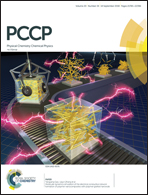Unravelling the enigma of ultrafast excited state relaxation in non-emissive aggregating conjugated polymers†
Abstract
We investigate a class of non-emissive conjugated polymers with very short excited state lifetimes believed to undergo singlet fission and relaxation to mid-gap forbidden excited states. Poly(3-decylthieneylenvinylene) (P3DTV) and its heavy atom analog, poly(3-decylseleneylenvinylene) (P3DSV), are strongly aggregating conjugated polymers that experience large excited state displacements along multiple vibrational modes. We demonstrate this Franck–Condon vibrational activity effectively disperses excitation energy into multiple non-radiative channels that can be explained using a simple, two-state potential energy surface model. Resonance Raman spectroscopy is sensitive to early Franck–Condon vibrational activity and we observe rich harmonic progressions involving multiple high frequency CC backbone symmetric stretching motions (∼1000–1600 cm−1) in both systems reflecting mode-specific excited state geometrical displacements. Transient absorption spectra confirm that efficient non-radiative processes dominate excited state relaxation dynamics which are confined to π-stacked aggregated chains. Surprisingly, we found little influence of the heteroatom consistent with efficient vibrational energy dissipation. Our results highlight the importance of aggregation and multi-dimensional Franck–Condon vibrational dynamics on the ability to harvest excitons, which are not usually considered in materials design and optimization schemes.



 Please wait while we load your content...
Please wait while we load your content...
